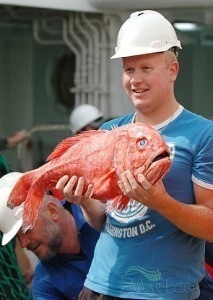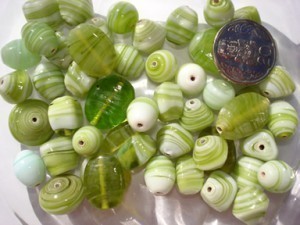What is the Size of a Orange Roughy?
The average size of the orange roughy ranges from 12 to 16 inches (30 to 40 cm). The  largest specimens measure 28 inches (75 cm) and weigh 15 lbs (8 kg). The fish is also known as the deep sea perch.
largest specimens measure 28 inches (75 cm) and weigh 15 lbs (8 kg). The fish is also known as the deep sea perch.
Classification
The orange roughy (Hoplostethus atlanticus) is of the genus Hoplostethus and belongs to the Trachichthyidae (the slimeheads) family. It is in the Beryciformes order.
Distribution
The fish is found in the eastern Atlantic Ocean, western Pacific Ocean and off the coasts of Chile. They are usually found in waters 590 to 5900 ft (180 to 1800 m) deep. The fish is particularly prevalent in Morocco, Iceland, Namibia, Australia and New Zealand.
Lifespan
While the size of the orange roughy is not unusual, its lifespan is. Scientific studies indicate the fish has a lifespan of 149 years. However there are some fishermen who dispute this claim.
Physical Description
In spite of its name, the fish has a brick red color. When it dies, the color turns into a yellow-orange. The fish is noted for being very late to mature. The fish has a deep body. Its head is notable for the various muciferous canals, which is usual for slimeheads.
These canals are actually a component of the lateral line system. The fish has one dorsal fin with 6 spines. There are about 18 soft rays on it. There are 10 to 12 soft rays on the anal fin. It has three spines.
Whatever the size of the orange roughy is, there is always between 19 to 25 ventral scutes. The pectoral fins range from 17 to 20. The fish has a forked caudal fin and has a bluish black interior mouth. The gill cavity is also bluish black. The lateral line has 28 to 32 scales. The fish is also noted for its big eyes.
Behavior
The fish tends to move sluggishly and they are often found in groups. The groups can be seen along seamounts or underwater canyons. They can be seen in areas where there is mixing and water movement.
The fish like these places because there is plenty of prey available. Research indicates the orange roughy goes on feeding / active and inactive phases. The pigmentation is lost when the fish is not active.
Diet and Predator
The orange roughy feeds on euphausiids, shrimp, amphipods and zooplankton. They will also consume smaller fish and crustaceans if available. Their natural enemies include the mackerels, sharks, snake mackerels and cutthroat eels.
Spawning
Their eggs measure 2.25 mm. It takes about 10 to 20 days for the eggs to hatch. The fish is one of the slowest growing in existence. It will reach maturity after 20 or 30 years. It is mainly due to the very slow maturity process that has made it difficult to repopulate the species.
The size of the orange roughy, coupled with its slow maturity, made it an easy prey for fisheries during the 1970s. Its population dwindled and in many areas it has been almost completely wiped out.





